A CEI-Based Method for Precise Tracking and Measurement of LEO Satellites in Future Mega-Constellation Missions
Abstract
:1. Introduction
2. Thesis Structure and Symbol Description
2.1. Thesis Structure
2.2. The Basic Scenario of the Proposed Method
2.3. Symbol Description
3. The Goniometric Model of LEO Satellites Based on CEI
3.1. CEI Goniometric Model for HEO Satellites Based on “Far-Field” Measurements
3.2. CEI Goniometric Model for LEO Satellites Based on “Near-Field” Measurements
4. The Analysis of Goniometric Errors in the Model
4.1. Goniometric Error Formula for the “Near Field” Model
4.2. The Analysis of Each Error Source in the Goniometric Error Equation
5. Analysis of Common View Time of Ground Station to Satellite and Simplification of Goniometric Error Formula
5.1. Analysis of Common View Time of LEO Satellites by CEI Ground Stations
5.2. Simplifying the Goniometric Error Formula
6. Simulation
6.1. Simulation of Common View Time of CEI Ground Station to Satellite
6.2. Effect of Variable Parameters on Error Coefficient
6.2.1. Effect of Satellite–Station Distance on Phase Difference Error Coefficient and Baseline Error Coefficient
- (1)
- The phase difference error coefficient increases with the increase in satellite–station distance, and it increases more when the angle of measurement is lower. For example, when the angle of measurement is 30° and the baseline length is 100 km, the difference error coefficient increases by 32.4% compared to the minimum value of simulation change range. When the angle of measurement is 80° and the baseline length remains unchanged, the difference error coefficient only increases by 6.6%. This is mainly because, the smaller the angle of measurement, the shorter the equivalent length of the baseline, resulting in the greater impact of error sources on the angle measurement accuracy.
- (2)
- The increase in baseline length has little effect on the increase in difference error coefficient, and the different baseline length curves in the figure are basically parallel. This is because the baseline length of CEI is too short compared with the satellite–station distance;
- (3)
- The baseline error coefficient increases with the increase in satellite–station distance when the angle of measurement is below 70°, and the shorter the baseline length and lower the angle of measurement, the greater the increase. This is similar to the equivalent baseline length mentioned in (1). For example, when the baseline length is 80 km and the angle of measurement is 60°, the baseline error coefficient increases by 50.2% compared to the minimum value of simulation change range.
6.2.2. Influence of Baseline Length on Phase Difference Error Coefficient and Baseline Error Coefficient
- (1)
- With an increase in baseline length, both the phase difference error coefficient and the baseline error coefficient decrease. This is consistent with the conclusion of the traditional “far-field” measurement model;
- (2)
- When the measuring angle is low, the impact of changes in baseline length on the error coefficient is significant. For example, when the measuring angle is 20° and the satellite–station distance is 600 km, the difference error coefficient decreases by 95.8%, while the baseline error coefficient decreases by 96.1%;
- (3)
- When the measuring angle is above 60°, there is little effect of increasing baseline lengths on reducing error coefficients;
- (4)
- Satellite–station distance has a relatively small impact on changes in baseline length and error coefficients, as seen from the overlapping curves in the figure.
6.2.3. Influence of Measuring Angles on Phase Difference Error Coefficient and Baseline Error Coefficient
- (1)
- With an increase in measuring angle, both the phase difference error coefficient and the baseline error coefficient decrease. This is consistent with the conclusion of the traditional “far-field” measurement model;
- (2)
- When the baseline length is short, the impact of changes in measuring angle on errors is significant. For example, at a baseline length of 50 km and a satellite–station distance of 600 km, the phase difference error coefficient decreases by 96.5%, while the baseline error coefficient decreases by four orders of magnitude;
- (3)
- Changes in satellite–station distance have a relatively small impact on changing errors due to measuring angles, as seen from the overlapping curves in the figure. It can be understood that the measurement angle is mainly changed by the equivalent baseline length, and the satellite station distance has no effect on it.
6.2.4. Conclusion of the Simulation Analysis of Each Parameter Included in the Error Source
- (1)
- When using CEI to measure angle information for low Earth orbit satellites, the length of baselines need not be excessively long and a baseline length greater than 150 km does not have a significant effect on error reduction. Additionally, shorter baselines are beneficial for achieving high precision time and frequency synchronization;
- (2)
- Angles should not be measured too low when measuring satellite position, taking into account interference such as echoes. The best goniometric angle is greater than 10°;
- (3)
- With an increase in the distance between the satellite and ground station, both the phase difference error coefficient and the baseline error coefficient will increase. As the unit angle error caused by higher orbit altitude leads to more significant positioning errors, attention should be paid to the introduced error increments due to increased satellite–station distances during high-precision measurements;
- (4)
- In situations where the angle is high, the baseline error coefficient may reach zero as it changes with the distance from the satellite and ground station. This condition can be utilized to achieve high-precision measurements of satellites.
6.3. The Theoretical Goniometric Accuracy of This Paper’s Model
7. Conclusions
Author Contributions
Funding
Data Availability Statement
Acknowledgments
Conflicts of Interest
References
- Farzan, F.; René, L. Multi-Constellation Software-Defined Receiver for Doppler Positioning with LEO Satellites. Sensors 2020, 20, 5866. [Google Scholar] [CrossRef]
- Mortlock, T.; Kassas, Z.M. Assessing Machine Learning for LEO Satellite Orbit Determination in Simultaneous Tracking and Navigation. In Proceedings of the 2021 IEEE Aerospace Conference (50100), Big Sky, MT, USA, 6–13 March 2021; pp. 1–8. [Google Scholar] [CrossRef]
- Kang, W.; Ahmed, E.M.; Chris, R. Integrity monitoring for precise orbit determination of LEO satellites. GPS Solut. 2021, 26, 32. [Google Scholar] [CrossRef]
- Darwish, T.; Kurt, G.K.; Yanikomeroglu, H.; Bellemare, M.; Lamontagne, G. LEO satellites in 5G and beyond networks: A review from a standardization perspective. IEEE Access 2022, 10, 35040–35060. [Google Scholar] [CrossRef]
- Zhou, J.; Bo, Q.; Sun, L.; Wang, J.; Yan, X. Routing Strategy for LEO Satellite Networks Based on Membership Degree Functions. Secur. Commun. Netw. 2020, 2020, 8822985. [Google Scholar] [CrossRef]
- McDowell, J.C. The Low Earth Orbit Satellite Population and Impacts of the SpaceX Starlink Constellation. Astrophys. J. Lett. 2020, 892, L36. [Google Scholar] [CrossRef] [Green Version]
- Tao, H.; Zhu, Q.; Che, X.; Li, X.; Man, W.; Zhang, Z.; Zhang, G. Impact of Mega Constellations on Geospace Safety. Aerospace 2022, 9, 402. [Google Scholar] [CrossRef]
- Al Homssi, B.; Al-Hourani, A.; Wang, K.; Conder, P.; Kandeepan, S.; Choi, J.; Allen, B.; Moores, B. Next generation mega satellite networks for access equality: Opportunities, challenges, and performance. IEEE Commun. Mag. 2022, 60, 18–24. [Google Scholar] [CrossRef]
- Duan, T.; Dinavahi, V. Starlink space network-enhanced cyber–physical power system. IEEE Trans. Smart Grid 2021, 12, 3673–3675. [Google Scholar] [CrossRef]
- Si, Y.; Zhang, E.; Zhang, W.; Ma, H.; Wu, T. A Survey on the Development of Low-Orbit Mega-Constellation and Its TT&C Methods. In Proceedings of the 2022 5th International Conference on Information Communication and Signal Processing (ICICSP), Shenzhen, China, 16–18 September 2022; pp. 324–332. [Google Scholar] [CrossRef]
- Chaudhry, A.U.; Yanikomeroglu, H. Laser intersatellite links in a starlink constellation: A classification and analysis. IEEE Veh. Technol. Mag. 2021, 16, 48–56. [Google Scholar] [CrossRef]
- Gallozzi, S.; Scardia, M.; Maris, M. Concerns about ground based astronomical observations: A step to safeguard the astronomical sky. arXiv 2020, arXiv:2001.10952. [Google Scholar] [CrossRef]
- Henri, Y. The OneWeb satellite system. In Handbook of Small Satellites: Technology, Design, Manufacture, Applications, Economics and Regulation; Springer: Berlin/Heidelberg, Germany, 2020; pp. 1–10. [Google Scholar] [CrossRef]
- Radtke, J.; Kebschull, C.; Stoll, E. Interactions of the space debris environment with mega constellations—Using the example of the OneWeb constellation. Acta Astronaut. 2017, 131, 55–68. [Google Scholar] [CrossRef]
- Zong, P.; Kohani, S. Design of LEO constellations with inter-satellite connects based on the performance evaluation of the three constellations SpaceX, OneWeb and Telesat. Korean J. Remote Sens. 2021, 37, 23–40. [Google Scholar]
- Xu, Y.; Zhang, Y.; Wang, Z.; He, Y.; Fan, L. Self-Organizing Control of Mega Constellations for Continuous Earth Observation. Remote Sens. 2022, 14, 5896. [Google Scholar] [CrossRef]
- Markovitz, O.; Segal, M. Advanced Routing Algorithms for Low Orbit Satellite Constellations. In Proceedings of the ICC 2021-IEEE International Conference on Communications, Montreal, QC, Canada, 14–23 June 2021; pp. 1–6. [Google Scholar] [CrossRef]
- Matricciani, E. Geocentric spherical surfaces emulating the geostationary orbit at any latitude with zenith links. Future Internet 2020, 12, 16. [Google Scholar] [CrossRef] [Green Version]
- Meng, Y.; Bian, L.; Han, L.; Lei, W.; Yan, T.; He, M.; Li, X. A global navigation augmentation system based on LEO communication constellation. In Proceedings of the 2018 European Navigation Conference (ENC), Gothenburg, Sweden, 14–17 May 2018; pp. 65–71. [Google Scholar] [CrossRef]
- Chen, L.; Lu, X.; Shen, N.; Wang, L.; Zhuang, Y.; Su, Y.; Li, D.; Chen, R. Signal acquisition of Luojia-1A low earth orbit navigation augmentation system with software defined receiver. Geo-Spat. Inf. Sci. 2022, 25, 47–62. [Google Scholar] [CrossRef]
- Yue, F.; Cui, Z.; Li, S.; Jing, H.; Zhang, S.; Wang, M. A Satellite Augmentation System based on LEO mega-constellation. In Proceedings of the 2022 International Conference on Artificial Intelligence, Information Processing and Cloud Computing (AIIPCC), Kunming, China, 19–21 August 2022; pp. 221–225. [Google Scholar] [CrossRef]
- Liu, G.-P.; Zhang, S. A Survey on Formation Control of Small Satellites. Proc. IEEE 2018, 106, 440–457. [Google Scholar] [CrossRef]
- Yu, B.; Huang, Z.; Geng, L.; Jin, D. Stability and ground experiments of a spinning triangular tethered satellite formation on a low earth orbit. Aerosp. Sci. Technol. 2019, 92, 595–604. [Google Scholar] [CrossRef]
- Brown, A.; Nguyen, D.; Silva, T.; Redd, J.; Linan, A. PNT as a Service (PNTaaS): Providing a Resilient Back-Up to GPS by Leveraging Broadband Satellite Constellations and Ground Infrastructure. In Proceedings of the 2023 IEEE/ION Position, Location and Navigation Symposium (PLANS), Monterey, CA, USA, 24–27 April 2023; pp. 388–398. [Google Scholar] [CrossRef]
- Schmidt, T.D.; Schuldt, T.; Michalak, G.; Surof, J.; Poliak, J.; Giorgi, G.; Braxmaier, C.; Meurer, M.; Günther, C. Optical Technologies for Future Global Navigation Satellite Systems. In Proceedings of the 2023 IEEE/ION Position, Location and Navigation Symposium (PLANS), Monterey, CA, USA, 24–27 April 2023; pp. 311–317. [Google Scholar] [CrossRef]
- Zhang, X.; Ma, F. Review of the development of LEO navigation-augmented GNS. Acta Geod. Cartogr. Sin. 2019, 48, 1073–1087. [Google Scholar] [CrossRef]
- Ma, F. Research on the Key Technologies for GNSS Precise Positioning Augmented with LEO Constellation. Ph.D. Thesis, Wuhan University, Wuhan, China, 2018. [Google Scholar]
- Ke, M.; Lv, J.; Zhu, M.; Wei, W.; Du, F. The Effect of LEO Satellite Orbital Error on Combined GPS and LEO Precise Point Positioning. In Proceedings of the 7th Annual Chinese Satellite Navigation Academic Conference, Changsha, Hunan, China, 18 May 2016; pp. 77–81. [Google Scholar]
- Li, X.; Ye, X.; Liu, W.; Wang, F. Precision single-point positioning of BDS/GPS/LEO with Fourier level fitting LEO orbit error. Glob. Position. Syst. 2021, 46, 16–24. [Google Scholar] [CrossRef]
- Xing, Y.; Cao, X.; Zhang, S.; Guo, H.; Wang, F. Relative position and attitude estimation for satellite formation with coupled translational and rotational dynamics. Acta Astronaut. 2010, 67, 455–467. [Google Scholar] [CrossRef]
- Wang, J.; Li, S.; Liu, C.; Wang, Z. Relative Position Keeping for Precise Formation Flying Using Linear Momentum Exchange. J. Guid. Control Dyn. 2023, 46, 978–988. [Google Scholar] [CrossRef]
- Hu, Y.; Bai, X.; Chen, L.; Yan, H. A new approach of orbit determination for LEO satellites based on optical tracking of GEO satellites. Aerosp. Sci. Technol. 2019, 84, 821–829. [Google Scholar] [CrossRef]
- Choi, J.; Jo, J.H.; Yim, H.-S.; Choi, E.-J.; Cho, S.; Park, J.-H. Optical tracking data validation and orbit estimation for sparse observations of satellites by the OWL-Net. Sensors 2018, 18, 1868. [Google Scholar] [CrossRef] [PubMed] [Green Version]
- Sun, X.; Shi, H.; Ji, Y. Passive measurement for synchronous orbit satellite with short base-lines interference of several stations. In Proceedings of the 2007 China Conference on Intelligent Automation, Lanzhou, China, 26–31 July 2007; pp. 1147–1152. [Google Scholar]
- Wilkinson, M.; Schreiber, U.; Procházka, I.; Moore, C.; Degnan, J.; Kirchner, G.; Zhongping, Z.; Dunn, P.; Shargorodskiy, V.; Sadovnikov, M. The next generation of satellite laser ranging systems. J. Geod. 2019, 93, 2227–2247. [Google Scholar] [CrossRef]
- Drożdżewski, M.; Sośnica, K. Tropospheric and range biases in Satellite Laser Ranging. J. Geod. 2021, 95, 100. [Google Scholar] [CrossRef]
- Ren, S.; Yang, X.; Wang, R.; Liu, S.; Sun, X. The Interaction between the LEO Satellite Constellation and the Space Debris Environment. Appl. Sci. 2021, 11, 9490. [Google Scholar] [CrossRef]
- Thurman, S. Information content of a single pass of phase-delay data from a short baseline connected element interferometer. Telecommun. Data Acquis. Rep. 1990, 26–38. [Google Scholar]
- Hong, J.C.; Lu, W.T.; Yang, W.G.; Wang, L.B. Processing and analysis of connected interferometric DOR signals based on frequency-phase estimation. J. Telem. Track. Command 2013, 34, 52–57. [Google Scholar] [CrossRef]
- Edwards, C. Goldstone intracomplex connected element interferometry. Telecommun. Data Acquis. Rep. 1990, 1–12. [Google Scholar]
- Du, L. Research on Precision Orbiting Technology of GEO Satellite. Ph.D. Thesis, PLA Information Engineering University, Zhengzhou, China, 2006. [Google Scholar]
- Liu, Z.; Du, L.; Zhu, Y.; Qian, Z.; Wang, J.; Liang, S. Investigation on GEO satellite orbit determination based on CEI measurements of short baselines. J. Navig. 2019, 72, 1585–1601. [Google Scholar] [CrossRef]
- Gao, Z.; Jiao, Y.; Teng, F.; Mao, F.; Li, C.; Wang, Y.; Si, Y.; Liu, R. A high-precision frequency estimation method for CEI signals of high-orbit satellites. In Proceedings of the GLOBECOM 2022—2022 IEEE Global Communications Conference, Rio de Janeiro, Brazil, 4–8 December 2022; pp. 3156–3161. [Google Scholar] [CrossRef]
- Sakamoto, Y.; Nishio, M. Orbit determination using radio interferometer of small-diameter antennas for LEO satellites. IEEE Trans. Aerosp. Electron. Syst. 2011, 47, 2111–2118. [Google Scholar] [CrossRef]
- Chen, L.; Lu, W.; Cao, J.; Shi, X.; Liu, Y.; Ren, T.; Ping, J. Technical Verification of Low Orbit Non-Cooperative Satellite Orbit Measurement and Determination Based on CEI System. Space Debris Res. 2021, 21, 30–36. [Google Scholar] [CrossRef]
- Li, X. Research on CEI-Based Precise Orbit Determination. Master’s Thesis, PLA Information Engineering University, Zhengzhou, China, 2009. [Google Scholar]
- Matricciani, E. A relationship between phase delay and attenuation due to rain and its applications to satellite and deep-space tracking. IEEE Trans. Antennas Propag. 2009, 57, 3602–3611. [Google Scholar] [CrossRef]
- Kawase, S.; Sawada, F. Interferometric tracking for close geosynchronous satellites. J. Astronaut. Sci. 1999, 47, 151–163. [Google Scholar] [CrossRef]
- Jia, H. Research on Passive Satellite Orbit Determination Technology Based on Interferometry. Master’s Thesis, University of Chinese Academy of Sciences (National Time Service Center, Chinese Academy of Sciences), Beijing, China, 2022. [Google Scholar]
- Schmidt, R. Multiple emitter location and signal parameter estimation. IEEE Trans. Antennas Propag. 1986, 34, 276–280. [Google Scholar] [CrossRef] [Green Version]
- Li, H.; Huang, L.; Hao, W.H. Interferometry Techniques for Deep Space Navigation; Tsinghua University Press: Beijing, China, 2022; pp. 133–138. [Google Scholar]
- Rosengren, M.; De Vicente-Olmedo, J.; Pedersen, F. Keeping track of geostationary satellites—A novel and less costly approach. ESA Bull. 2004, 119, 64–68. [Google Scholar]
- Del Portillo, I.; Cameron, B.G.; Crawley, E.F. A technical comparison of three low earth orbit satellite constellation systems to provide global broadband. Acta Astronaut. 2019, 159, 123–135. [Google Scholar] [CrossRef]

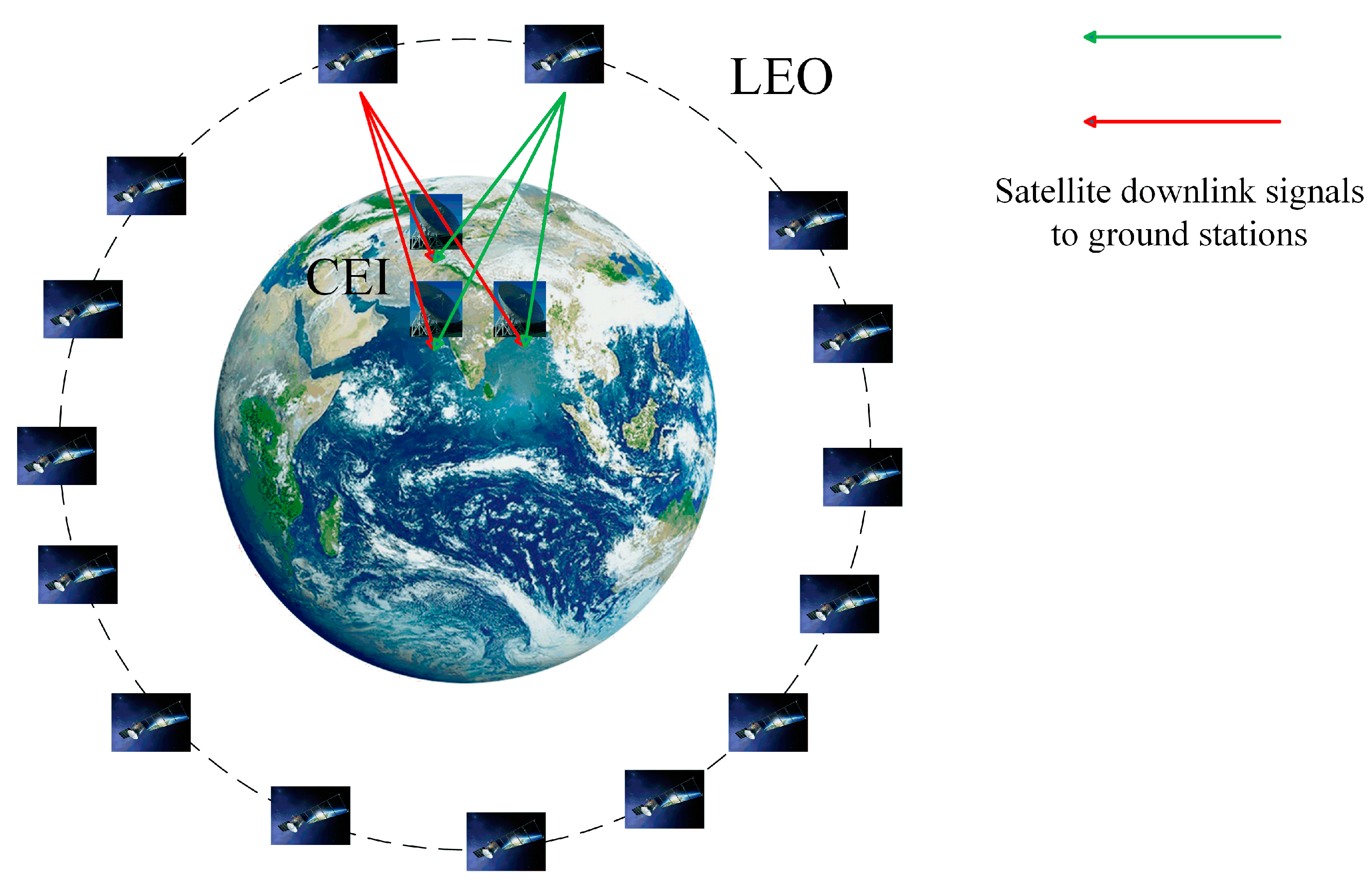
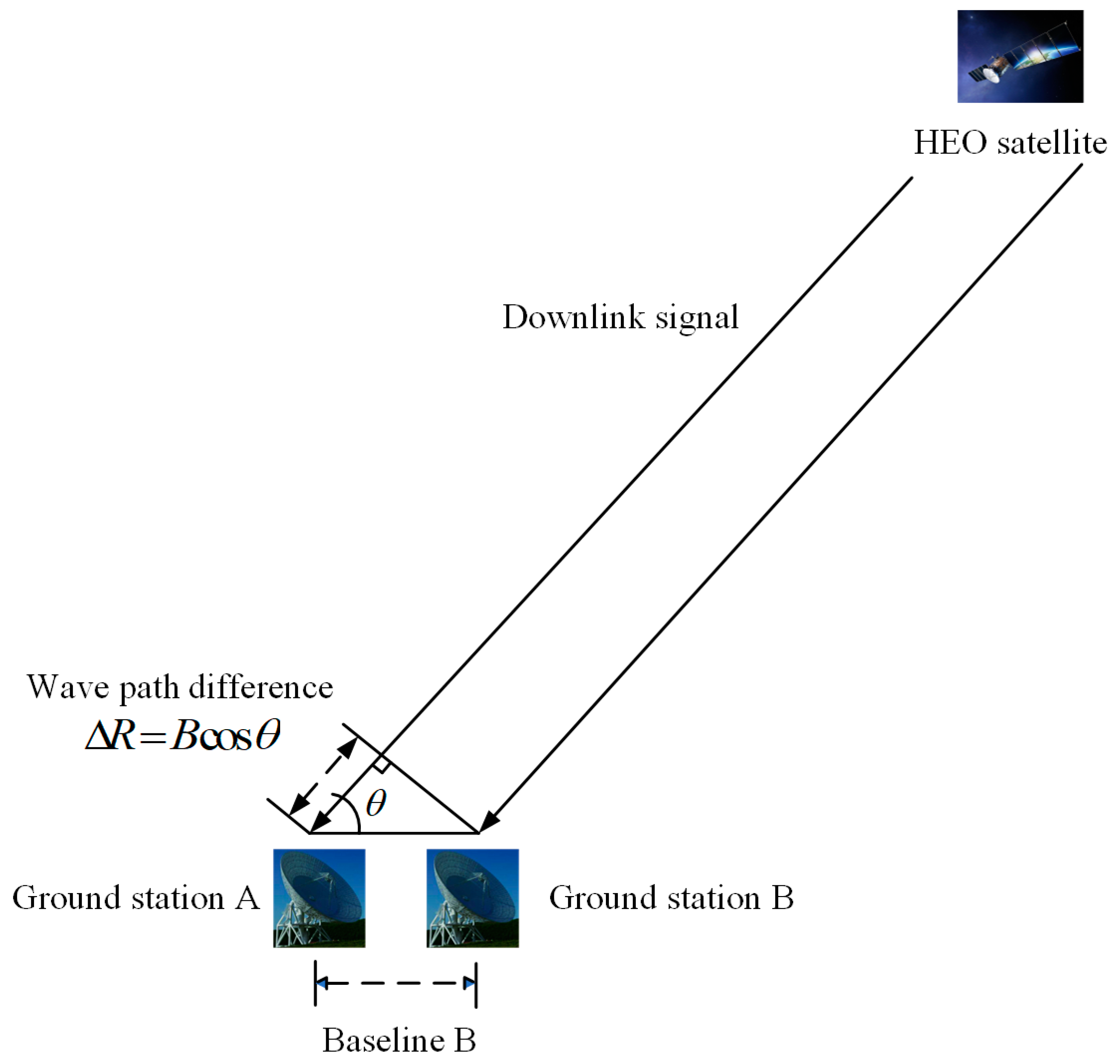

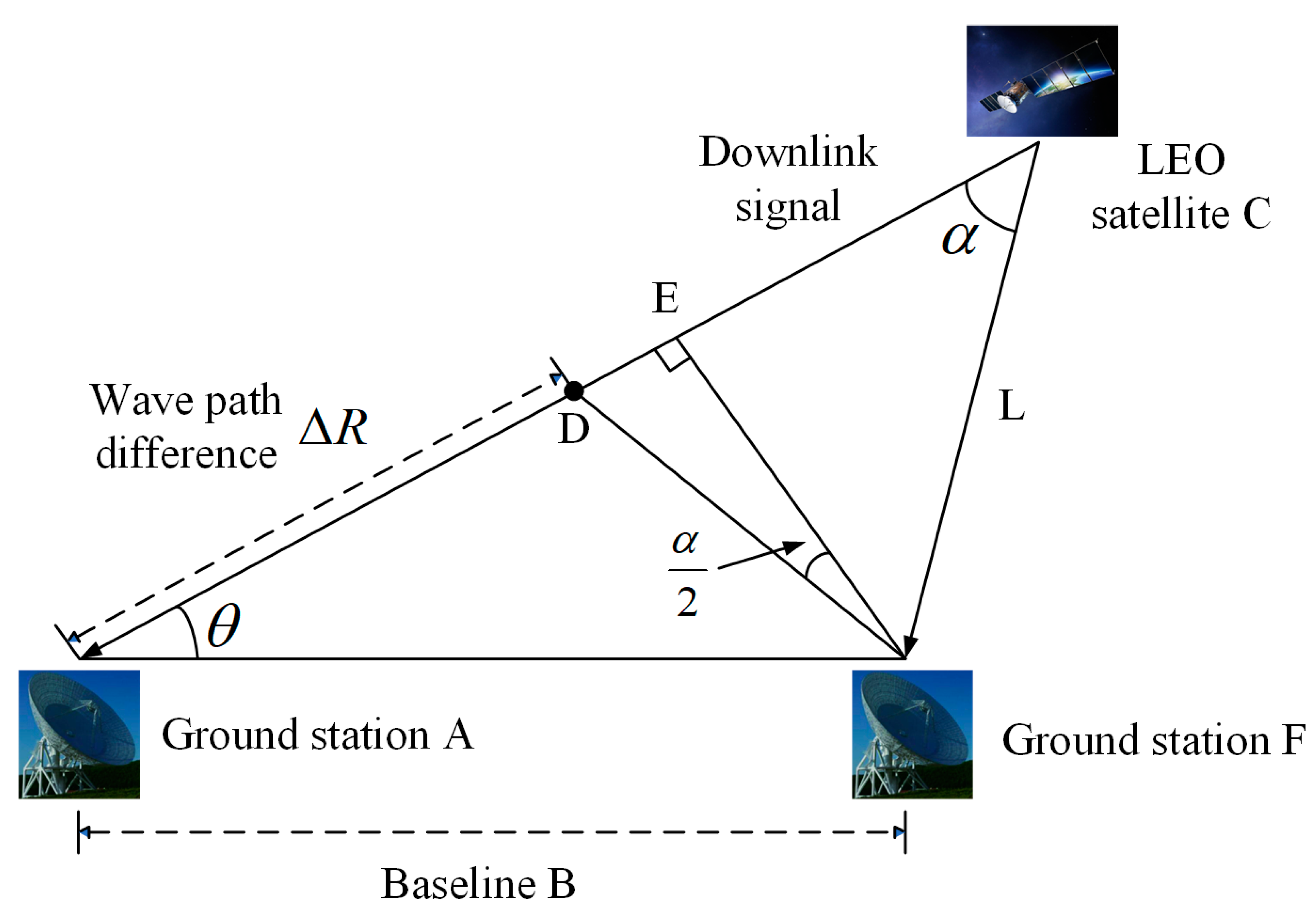

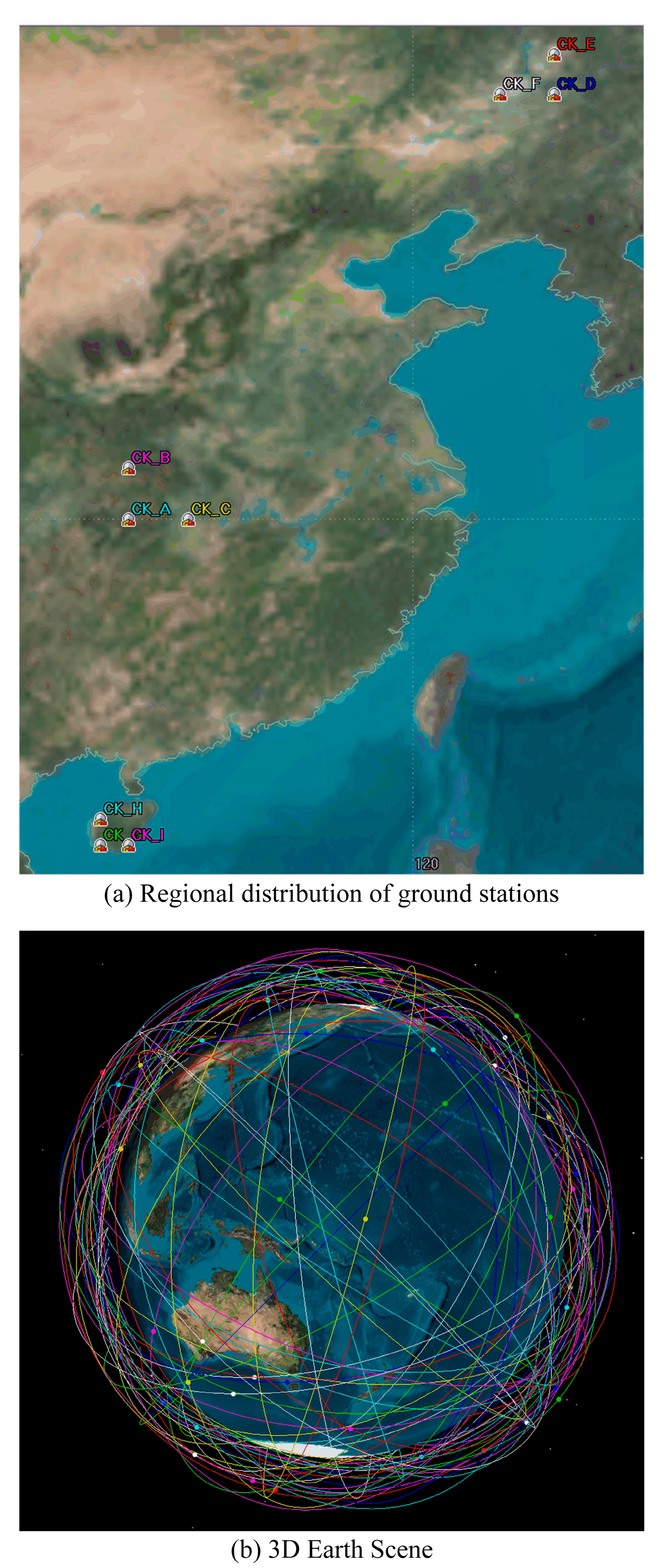
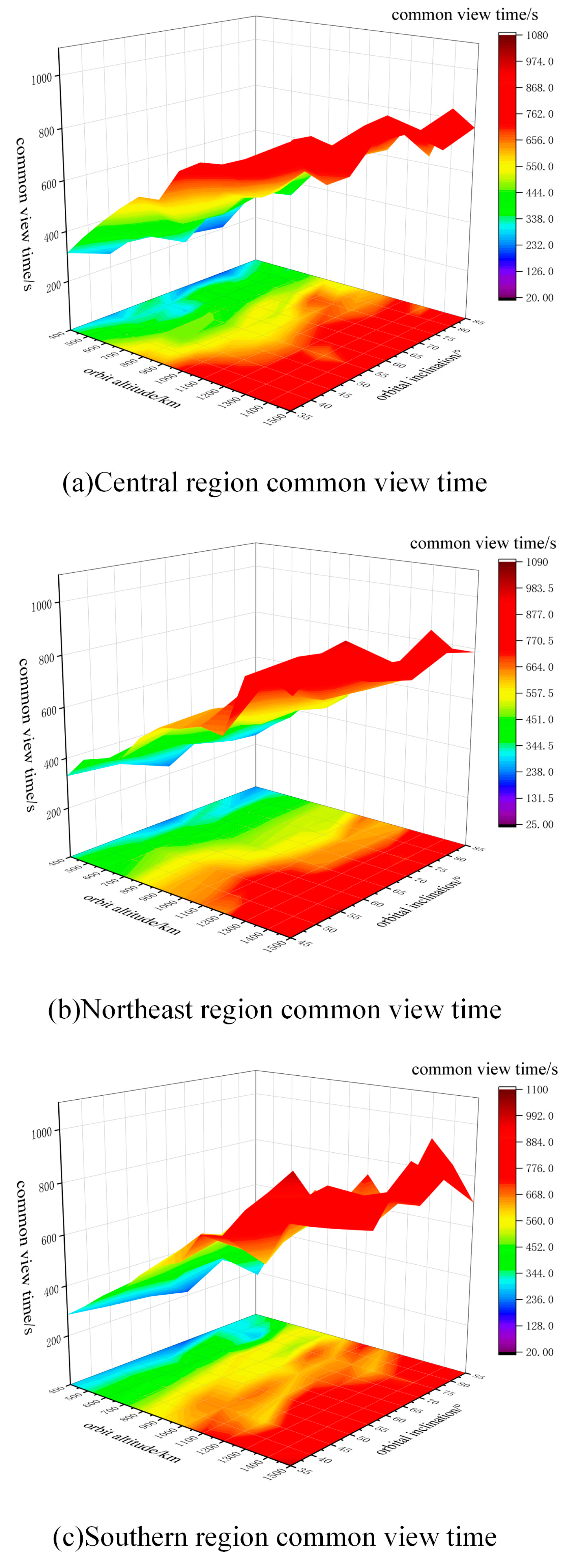

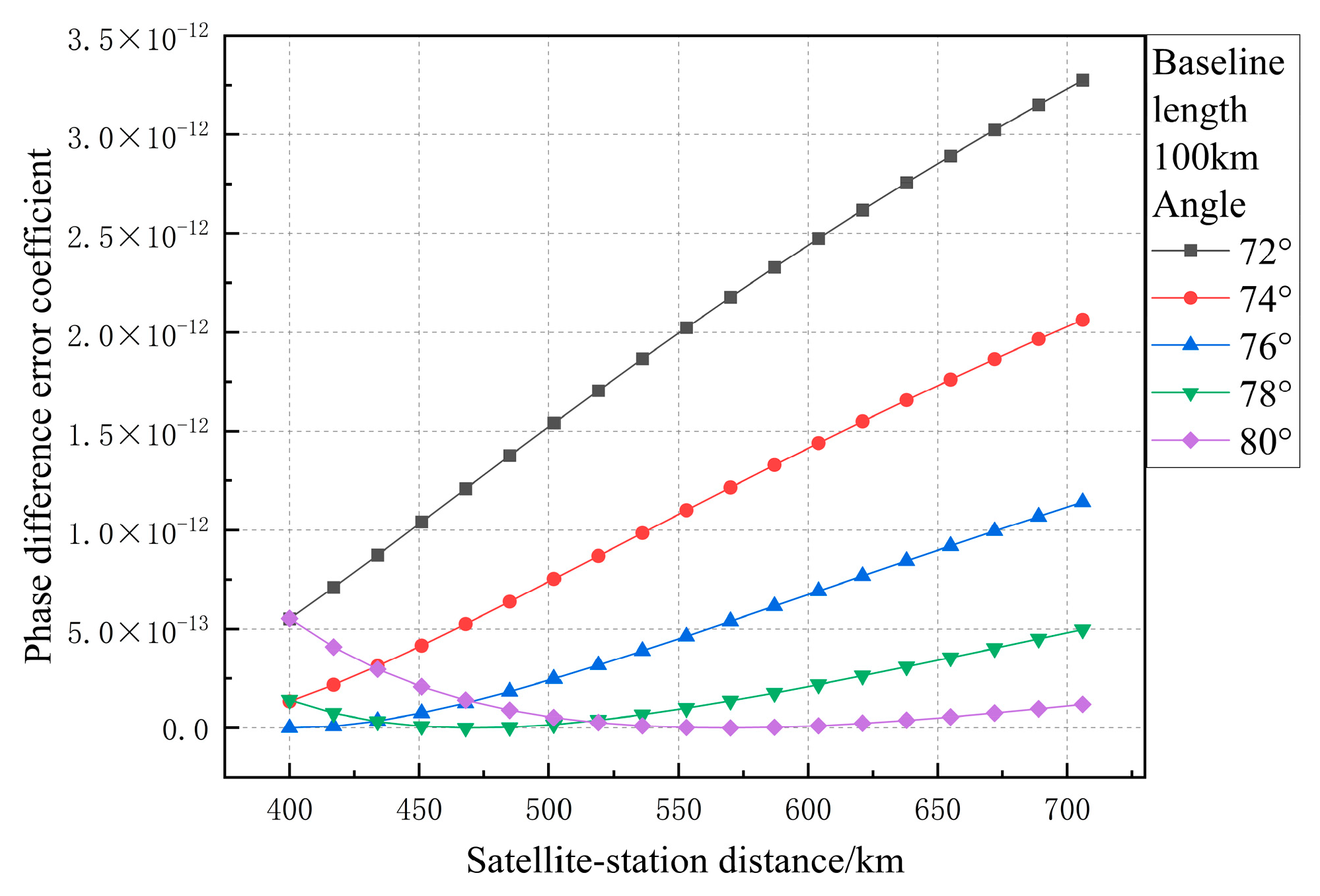


| Symbols | Description |
|---|---|
| Baseline length of CEI array | |
| Two-dimensional plane angle between the satellite and ground station line and the CEI baseline | |
| Distance between satellite and ground station | |
| Speed of light | |
| Phase difference between two ground stations receiving downlink signals from the same satellite | |
| Satellite downlink signal frequency | |
| Goniometric error | |
| Baseline length error | |
| Downlink signal frequency error | |
| Phase difference error | |
| Satellite–station distance error |
| Satellite/Constellation | Orbit Altitude/km | “Far-Field” Model Wave Range Error/m * | Ratio of Orbit Altitude to Baseline Length * |
|---|---|---|---|
| GPS-PPS | 20,200 | 0.39 | 4040 |
| Viasat | 36,000 | 0.23 | 7200 |
| Starlink | 550 | 14.8 | 110 |
| Oneweb | 1200 | 6.8 | 240 |
| Constellation | Telesat | OneWeb | Starlink | GW | |
|---|---|---|---|---|---|
| Parameters | |||||
| Orbit altitude and Orbital inclination | 1000 km (99.5°) 1248 km (37.4°) | 1200 km (87.9°) | 1150 km (53°) 1110 km (53.8°) 1130 km (74°) 1275 km (81°) 1325 km (70°) | 590 km (85°) 600 km (50°) 508 (55°) 1145 (30–60°) | |
| Downlink signal frequency/GHz | 18.5 | 13.5 | 13.5 | ||
| Bandwidth | 0.25 | 0.25 | 0.25 | ||
| Regions | Latitude, Longitude and Array Baseline Length of Ground Stations | |
|---|---|---|
| Central Region | ground station A | (110° E, 30° N) |
| ground station B | (110° E, 31.8° N) | |
| ground station C | (112.1° E, 30° N) | |
| baseline length | 200 km | |
| Northeast Region | ground station D | (125° E, 45° N) |
| ground station E | (125° E, 46.4° N) | |
| ground station F | (123.1° E, 45° N) | |
| baseline length | 150 km | |
| Southern Region | ground station G | (109° E, 18.5° N) |
| ground station H | (109° E, 19.4° N) | |
| ground station I | (110° E, 18.5° N) | |
| baseline length | 100 km | |
| Parameters | Range of Variation |
|---|---|
| Range of antenna operating angles | 10–170° |
| Operating frequency band | Ku (13.2–13.8 GHz) |
| K (18.2–18.8 GHz) | |
| Antenna gain | Ku-band, G dBi |
| K-band, G dBi | |
| Noise temperature | Ku band 78.6 K |
| K-band 84.2 K | |
| Low noise amplifier gain | Ku band 45 dB |
| K-band 45 dB | |
| Paraflap characteristics | Ku/K band first flap level −14 dB below main flap level |
| Tracking method | program tracking, step tracking |
| Tracking accuracy | <1/10 half-power beamwidth |
| Parameters | Range of Variation |
|---|---|
| Orbit altitude | 400–1500 km with 100 km interval change |
| Orbital inclination | Central region, southern region: 35–85° with 10° interval variation |
| Northeast region: 45–85° with 10° interval change | |
| Ascending node equinox | 0–360° range randomly selected |
| Perigee angle | No restrictions |
| True near point angle | No restrictions |
| Simulation time | 4 June 2023 0:00–5 June 2023 0:00, 24 h in total |
| Main Simulation Variable and Variation Range | Range of Variation in Additional Information | The Serial Number of Figures and the Type of Error Coefficient It Plots | |||
|---|---|---|---|---|---|
| (a) Phase Difference Error | (b) Phase Difference Error | (c) Baseline Error | (d) Baseline Error | ||
| Satellite–station distance 400–1500 km | goniometric angle/° | 60 | 30/40/50/60/80 | 60 | 30/40/50/60/70 |
| Baseline length/km | 80/90/100/120/150 | 100 | 80/90/100/120/150 | 100 | |
| Main Simulation Variable and Variation Range | Range of Variation in Additional Information | The Serial Number of Figures and the Type of Error Coefficient It Plots | |||
|---|---|---|---|---|---|
| (a) Phase Difference Error | (b) Phase Difference Error | (c) Baseline Error | (d) Baseline Error | ||
| baseline length 50–200 km | goniometric angle/° | 20/40/60/90 | 60 | 20/40/60/90 | 60 |
| satellite–station distance/km | 600 | 400/700/1000/1500 | 600 | 400/700/1000/1500 | |
| Main Simulation Variable and Variation Range | Range of Variation in Additional Information | The Serial Number of Figures and the Type of Error Coefficient It Plots | |||
|---|---|---|---|---|---|
| (a) Phase Difference Error | (b) Phase Difference Error | (c) Baseline Error | (d) Baseline Error | ||
| goniometric angle 10–90° | baseline length/km | 50/70/100/150 | 100 | 50/70/100/150 | 100 |
| satellite–station distance/km | 600 | 400/700/1000/1500 | 600 | 400/700/1000/1500 | |
| Angle/° | 40 | 50 | 60 | 70 | 80 | |
|---|---|---|---|---|---|---|
| Baseline Length/km | ||||||
| 10 | 15,188 * | 10,717 | 8407 | 7161 | 6541 | |
| 20 | 3740 | 2645 | 2081 | 1778 | 1629 | |
| 50 | 572 | 407 | 323 | 279 | 258 | |
| 100 | 133 | 96 | 76 | 67 | 63 | |
| 120 | 89 | 65 | 52 | 46 | 43 | |
| 160 | 47 | 35 | 28 | 25 | 24 | |
| 200 | 29 | 21 | 17 | 16 | 15 | |
| 240 | 19 | 14 | 12 | 11 | 10 | |
Disclaimer/Publisher’s Note: The statements, opinions and data contained in all publications are solely those of the individual author(s) and contributor(s) and not of MDPI and/or the editor(s). MDPI and/or the editor(s) disclaim responsibility for any injury to people or property resulting from any ideas, methods, instructions or products referred to in the content. |
© 2023 by the authors. Licensee MDPI, Basel, Switzerland. This article is an open access article distributed under the terms and conditions of the Creative Commons Attribution (CC BY) license (https://creativecommons.org/licenses/by/4.0/).
Share and Cite
Zhang, E.; Wu, T.; Hu, M.; Yang, W.; Ma, H.; Jiao, Y.; Shi, X.; Gao, Z. A CEI-Based Method for Precise Tracking and Measurement of LEO Satellites in Future Mega-Constellation Missions. Electronics 2023, 12, 3385. https://doi.org/10.3390/electronics12163385
Zhang E, Wu T, Hu M, Yang W, Ma H, Jiao Y, Shi X, Gao Z. A CEI-Based Method for Precise Tracking and Measurement of LEO Satellites in Future Mega-Constellation Missions. Electronics. 2023; 12(16):3385. https://doi.org/10.3390/electronics12163385
Chicago/Turabian StyleZhang, Entao, Tao Wu, Minchao Hu, Wenge Yang, Hong Ma, Yiwen Jiao, Xueshu Shi, and Zefu Gao. 2023. "A CEI-Based Method for Precise Tracking and Measurement of LEO Satellites in Future Mega-Constellation Missions" Electronics 12, no. 16: 3385. https://doi.org/10.3390/electronics12163385





